List of temples in Kanchipuram
Kānchipuram ([kaːɲdʑipuɾam]), or Kānchi or Kāncheepuram, is a famous temple city in the Indian state of Tamil Nadu. It served as the capital city of the Pallava Kingdom. It is also known by its former names Kanchiampathi, Conjeevaram, and the nickname "The City of Thousand Temples" [1] It is now the Administrative headquarters of Kanchipuram district. Kanchipuram is located 72 kilometers from Chennai, the capital city of the southern state of Tamil Nadu, India.
Kānchipuram is considered one of the seven holiest cities to the Hindus of India. In Hinduism, a kṣetra is a sacred ground, a field of active power, a place where moksha, final release can be obtained. The Garuda Purana enumerates seven cities as providers of moksha, namely Ayodhya, Mathura, Haridwar, Varanasi, Avantikā, Dvārakā and Kanchipuram.
List of temples
Among the major Hindu temples in Kānchipuram are some of the most prominent Vishnu Temples and Shiva Temples of Tamil Nadu like the Varadharaja Perumal Temple for Vishnu and the Ekambaranatha Temple which is the "earth abode" of Shiva. Kamakshi Amman Temple, Kumara Kottam, Kachapeshwarar Temple, and the Kailasanathar Temple are some of the other prominent temples.
* Divya desams - temples dedicated to Vishnu glorified in the Divya Prabandha, the early medieval Tamil literature canon of the Alvar saints from the 6th–9th centuries CE.There are 15 Divya desam in Kanchipuram.
* Padal petra stalam - where the three of the most revered Nayanars (Saivite Saints), Appar, Sundarar and Tirugnana Sambandar have glorified the Shiva temples in Tevaram during the 7th-8th centuries.There are 11 paadal petra stalam in Kanchipuram.
| Name of the temple | Photo | Architecture/Timeline | Notes/Beliefs | |
|---|---|---|---|---|
| Shiva Temples | ||||
| Ekambareswarar Temple (Kachi Ekambam) | 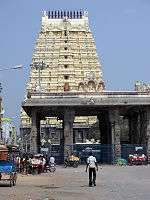 |
600 CE, Pallavas, Present structure - Nayaks of Tanjore | The temple is the largest temple in the town of Kanchipuram and is located in the northern part of the town.[2] The temple gopuram (gateway tower) is 59m tall, which is one the tallest gopurams in India.[3] It is one of the Pancha Bhoota Stalams representing earth (Sanskrit: पन्च भूत स्थल) referring to the five temples,[4] dedicated to Shiva, a Hindu god, each representing the manifestation of the five prime elements of nature- land, water, air, sky and fire.[5] | |
| Kailasanathar Temple | .jpg) |
567 CE foundation, Expansion in 7th century by Rajasimha Pallava[6] | The temple is the oldest Pallava temple still in existence and is declared an archeological monument by Archaeological Survey of India. The temple is architecturally considered splendid and its plan is peculiar in having a series of cells with sculptures within.[6] | |
| Karchapeswarar Temple |  |
Pallava dynasty,[7] present structure by Vijayanagar rulers[8] | Vishnu is believed to have worshipped Shiva in the form of kurma (tortoise).[6] The other name given to the temple is Kachipedu in some inscriptions.[6] The temple is adjacent to the Kanthakottam temple. | |
| Sathyanatheswarar Temple ( Kachi Nerikkaaraikkadu) | 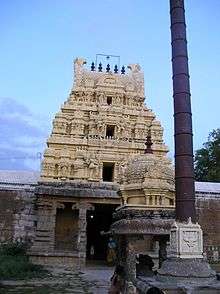 |
Tirugnana Sambandar, a 7th-century Tamil Saivite poet, venerated Sathyanatheswarar in one verse in Tevaram, compiled as the First Tirumurai. As the temple is revered in Tevaram. | ||
| Metraleeswar Temple (Kachi Metrali) | 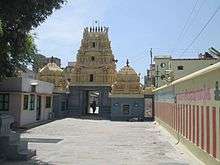 |
Appar and Sambandar, the 7th-century Tamil Saivite poet, venerated Metralinathar in one verse each in Tevaram, compiled as the First Tirumurai. | ||
| Ona Kantheeswarar Temple (Onakanthan Thali) |  |
Onakandan means the lover of the Sravana constellation and Metrali refers to southern side.[9] | ||
| Anekadhangavadeswarar Temple (Kachi Anekatangapadam) |  |
The temple is believed to be in forest frequented by large set of people.[9] The temple is close to the Kailasantha temple in a very small campus. | ||
| Kuranganilmuttam | Pallavas[10] | The temple is close to Mamandur, south of Kanchipuram. The temple has a rock cut shrine of Pallava origin associated with monkey, squirrel and crow (kurangu, Anil and Mutram in Tamil).[10] The temple has been revered by Campantar's Tevaram.[10] | ||
| Muktheeswarar Temple | Nandivarman II | The temple is in dilapidated state and has inscriptions dating back to the Pallava period. The sculpture in front mandapa (hall) has bold outlines.[9] | ||
| Vazhakarutheeswarar Temple | Vazhakku indicates case - worship in this temple is believed to relieve people of all their litigations.[11] The temple attained significance when Vasanthi Stanli, a Dravida Munnetra Kazhagam party functionary prayed for Kanimozhi (the daughter of ex-chief minister of Tamil Nadu, Karunanidhi and accused in 2G spectrum case), offered special worship to relieve her of trial of 2G spectrum case.[11] | |||
| Iravatanesvara Temple, Kanchipuram | 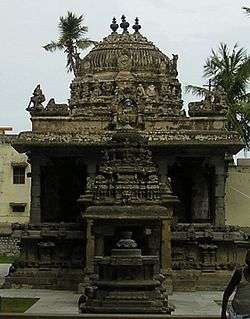 |
Pallavas, 8th century CE | It is famous for its splendid vimana and the circular sanctum.[12] This temple was built by Pallava King Narasimhavarman II (Rajasimhan). The temple is maintained by Archaeological Survey of India and is a protected monument.[13] | |
| Shakti Temples | ||||
| Kamakshi Amman Temple |  |
Pallavas in 6th century and modified in 14th-17th century [14] | The goddess is depicted in the form of an yantra. Chakra or peetam (basement) is where the deity placed. But in this temple, the yantra is placed in front of the deity.[15] Adi Sankara is closely associated with this temple and believed to have established the Kanchi matha after this temple. The mutt's official history states that it was founded by Adi Sankara of Kaladi, and that His Holiness Jayendra Saraswati Swami is the current pontiff - The 69th head in succession, tracing its history back to the 5th century BCE.[16] A related claim is that Adi Sankara came to Kanchipuram, and that he established the Kanchi mutt named "Dakshina Moolamnaya Sarvagnya Sri Kanchi Kamakoti Peetam" in a position of supremacy (Sarvagnya Peetha) over the other mathas of the subcontinent, before his death there. | |
| Other Hindu Temples | ||||
| Kumarakottam | 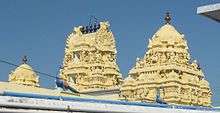 |
The temple is dedicated to Muruga (called Skanda), the son of Shiva and Parvathi and is located between the Ekambareswarar temple and Kamakshi Amman temple leading to the cult of Somaskanda (Skanda, the child between Shiva and Parvathi). The temple is the birthplace of Kandapuranam, the Tamil religious work on Muruga translated from Sanskrit Skandapurana in 1625 CE by Kachiappa Shivacharya.[8] | ||
| Chitragupta temple | 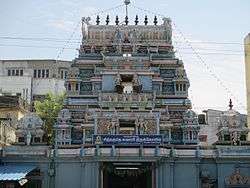 |
Cholas - 9th century CE[17][18] | Chitragupta, as per Hinduism is the younger brother of Yama, the death god, who keeps track of good and bad deeds of humanbeings to decide their residence in heaven or hell.[18] The temple is just one of its kind that has a separate temple for Chitragupta.[18] The panchaloha (alloy made of five elements) idol of the deity and his consort was found during an excavation process during 1911 CE.[18] | |
| Jain Temples | ||||
| Trilokyanatha Temple - Jain Temple | .jpg) |
8th century CE, Pallavas[7] | Trilokyanatha/Chandraprabha temple is a twin jain temple having inscriptions from Pallava king, Narasimhavarman II and the Chola kings Rajendra Chola I, Kulothunga Chola I and Vikrama Chola, and the Kanarese inscriptions of Krishnadevaraya. The temple is maintained by Tamil Nadu archaeological department.[19] | |
| Vishnu Temples | ||||
| Varadharaja Perumal Temple |  |
1053 CE, Cholas, present structure 14th-15th century, Nayaks of Tanjore | Varadharaja Perumal Temple was originally built by the Cholas in 1053[20] and it was expanded during the reigns of the great Chola kings Kulottunga Chola I and Vikrama Chola. In the 14th century another wall and a gopura was built by the later Chola kings. It is an ancient temple and one of the 108 divyadesams, the holy abodes of Vishnu. It is located in part of Kanchipuram called the Vishnu Kanchi that is a home for a lot of famous Vishnu temples, including this one. Varadharaja Perumal Temple is a huge one on a 23-acre (93,000 m2) complex and shows the architectural skills of ancient vishwakarma sthapathis in temple architecture and is famous for its holiness and ancient history. Another significant thing about the temple are beautiful carved lizards and platted with gold, over the sanctum.[21] | |
| Ashtabujakaram - Sri Adhikesava Perumal Temple | .jpg) |
The deity is with eight hands and hence called asta bhujakaram. | ||
| Tiruvekkaa - Sri Yathothkari Temple | .jpg) |
The deity here is termed "Sonna vannam seitha Perumal" meaning the truth sayer. It lies west of Varadaraja Perumal temple.[22] | ||
| Tiruththanka - Sri Deepa prakasa Perumal Temple |  |
There are shrines for Lakshmi Hayagriva, Andal, Vedanta Desika and Alwars. It is the birthplace of Vedanta Desika. There is a separate shrine for Hayagreeva along with Vedanta Desika. | ||
| Tiruvelukkai - Sri Azhagiya Singar Temple |  |
The temple is known for the Narasimha (lion form) avatar of Vishnu. | ||
| Tirukalvanoor - Sri Adi Varaha Swami Temple | The temple is a small shrine inside the Kamaakshi Amman temple precinct. | |||
| Tiruoorakam - Sri Ulagalantha Swami Temple |  |
846-869 CE, Nandivarman III[23] | The temple is believed to have stood in Karikala hall, after ancient Chola king Karikala. Inscriptions indicate the existence of the hall in olden days.[24] All the four temples are enshrined in the same complex.[22] | |
| Tiruneeragam - Sri Jagadeeshwarar Temple | ||||
| Tirukaaragam - Sri Karunagara Perumal Temple | ||||
| Tirukaarvaanam - Sri Tirukaarvarnar Temple | ||||
| Tiruparamechura Vinnagaram - Sri Vaikunda Perumal Temple | Late 8th century, Nandivarman II[25] | The place is the birthplace of the azhwar saint, Poigai Alvar.[25] The central shrine has tiers of 3 shrines, one over the other, with Vishnu depicted in each of them.[25] The prakaram (corridors round the sanctum) has series of sculptures depicting the Pallava rule and conquer.[25] | ||
| Tirupavalavannam - Sri Pavala Vanar Temple |  |
The temple faces west and the twin aswins have worshipped the deity here.[22] | ||
| Tirupaadagam - Sri Pandava Thoodar Temple | .jpg) |
Expanded in 1070-1120 CE, Kulothunga Chola I[17][24] | The temple has a set of inscriptions associated with Cholas. A record of the Chola king, Rajakesari Varaman alais Kulothunga Chola I, dated in his fifth year.[24] | |
| Tirunilaaththingalthundam - Sri Nilathingal Thundathan Perumal Temple | The temple is a small shrine close to the sanctum sanctorum of the Ekambranathar temple. | |||
| Tirupputkuzhi - Sri Vijaya Raghava Perumal Temple | 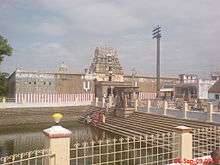 |
|||
Notes
- "Tourist Places". Government of Tamil Nadu. 2001. Archived from the original on 23 April 2012.
- Let's Go (2004), Let's Go India & Nepal 8th Edition, NY: Let's Go Publications, p. 584, ISBN 0-312-32006-X
- Sajnani 2001, pp. 305
- Ramaswamy 2007, pp. 301-302
- A dictionary, Canarese and EnglishWilliam Reeve, Daniel Sanderson
- Ayyar 1991, pp. 73
- "Temples". 2001. Archived from the original on 11 February 2015.
- Rao 2008, p. 110
- Ayyar 1991. p. 86
- Soundara Rajan 2001, p. 27
- "DMK distances itself from poojas for Kanimozhi by Party MP". Archived from the original on 4 March 2016. Retrieved 29 January 2012.
- Ayyar 1991, p. 74
- "List of protected monuments in Tamil Nadu maintained by ASI".
- Abram, David; Edwards, Nick; Ford, Mike; Jacobs, Daniel; Meghji, Shafik; Sen, Devdan; Thomas, Gavin (2011), The Rough guide to India, Rough Guides, p. 456, ISBN 978-1-84836-563-6
- Ayyar 1991, pp. 70-71
- "Kamakoti.org".
- Rao 2008, p. 111
- "The Hindu : Shrine for Chitragupta". 2003.
- "Deprived of original élan". 2011.
- "Abodes of Vishnu - Thirukkachchi".
- "Gateway to Kanchipuram district - Varadaraja Temple". Archived from the original on 30 July 2013.
- Ayyar 1991, p. 539
- Rao 2008, p. 109
- Ayyar 1991, p. 75
- Ayyar 1991, p. 80
References
- Ayyar, P. V. Jagadisa (1991), South Indian shrines: illustrated, New Delhi: Asian Educational Services, ISBN 81-206-0151-3.
- K.R., Subramanian; K. R., Subramanian (M.A.) (2002), The origin of Saivism and its history in the Tamil land, New Delhi: Asian Educational Services, ISBN 81-206-0144-0
- Ramaswamy, Vijaya (2007), Historical dictionary of the Tamils, United States: Scarecrow Press, INC., ISBN 978-0-470-82958-5
- Rao, P.V.L. Narasimha (2008), Kanchipuram - Land of Legends, Saints & Temples, New Delhi: Readworthy Publications (P) Ltd., ISBN 978-93-5018-104-1
- Sajnani, Dr. Manohar (2001), Encyclopedia of tourism resources in India, Volume 2, Delhi: Kalpaz Publications, ISBN 81-7835-014-9.
- Soundara Rajan, Kodayanallur Vanamamalai (2001), Concise classified dictionary of Hinduism, New Delhi: Concept Publishing Company, ISBN 81-7022-857-3.
External links
| Wikimedia Commons has media related to Temples in Kanchipuram district. |